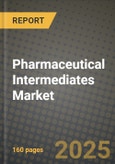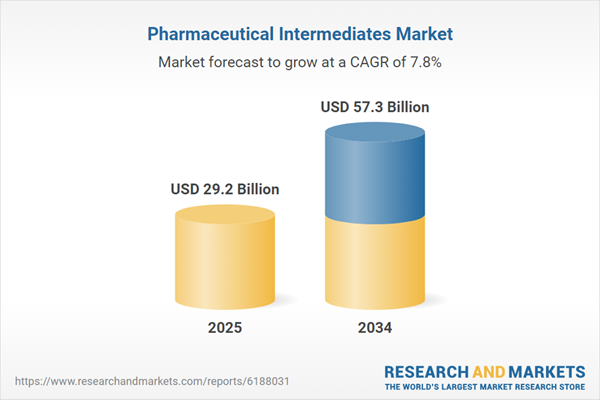The pharmaceutical intermediates market is a vital segment of the pharmaceutical industry, providing essential raw materials for the synthesis of active pharmaceutical ingredients (APIs) and finished drug formulations. Pharmaceutical intermediates serve as chemical building blocks in drug manufacturing, enabling the production of a wide range of medications, including antibiotics, antivirals, analgesics, and cardiovascular drugs. The market is driven by increasing pharmaceutical R&D activities, growing demand for generic and specialty drugs, and expanding drug production capabilities worldwide. North America and Europe lead the market due to their advanced pharmaceutical manufacturing infrastructure and stringent regulatory standards. Meanwhile, Asia-Pacific, particularly India and China, is emerging as a dominant supplier of pharmaceutical intermediates due to cost advantages, abundant raw material availability, and expanding production capacities. The growing focus on supply chain security, sustainable manufacturing practices, and advanced chemical synthesis technologies is further shaping the industry. As pharmaceutical companies prioritize efficiency, cost reduction, and regulatory compliance, the demand for high-quality pharmaceutical intermediates is expected to continue rising.
The pharmaceutical intermediates market witnessed key developments, including increased investments in green chemistry, the rise of biotechnological synthesis methods, and regulatory shifts aimed at enhancing quality control. The push for sustainability led to the adoption of environmentally friendly manufacturing processes, reducing solvent waste and energy consumption in intermediate production. The demand for high-purity intermediates surged, driven by the expansion of biologics and precision medicine. Regulatory agencies such as the FDA and EMA implemented stricter guidelines on raw material sourcing, compelling manufacturers to improve traceability, documentation, and compliance with Good Manufacturing Practices (GMP). Supply chain challenges, including geopolitical tensions and raw material shortages, prompted pharmaceutical companies to diversify sourcing strategies and invest in regional production hubs to ensure uninterrupted supply. Additionally, digital transformation gained momentum, with AI-driven predictive analytics optimizing intermediate synthesis processes, reducing production costs, and enhancing efficiency in pharmaceutical supply chains.
The pharmaceutical intermediates market is expected to experience further innovations in biocatalysis, AI-driven chemical synthesis, and localized manufacturing. AI-powered drug development will accelerate the identification of novel intermediates, improving reaction efficiency and reducing reliance on traditional chemical synthesis methods. The expansion of biosimilars and personalized medicine will drive the need for specialized intermediates tailored to complex drug formulations. Asia-Pacific is projected to dominate the market further, with increasing government support for local pharmaceutical production and investments in R&D infrastructure. Sustainability initiatives will play a larger role, with companies adopting carbon-neutral manufacturing processes and biodegradable solvents to align with global environmental regulations. However, challenges related to pricing volatility, stringent regulatory compliance, and patent expirations will continue to shape market dynamics, requiring pharmaceutical companies to innovate and optimize production processes. As the pharmaceutical industry evolves, high-quality and cost-effective intermediates will remain essential for the development of innovative drugs and therapeutics.
Key Insights: Pharmaceutical Intermediates Market
- Rise of Green Chemistry and Sustainable Manufacturing: Pharmaceutical companies are increasingly adopting environmentally friendly synthesis methods, reducing solvent waste, and minimizing energy consumption in intermediate production.
- Increased Use of AI in Chemical Synthesis: AI-driven predictive modeling and automation are optimizing the design of pharmaceutical intermediates, improving reaction efficiency, and reducing overall production costs.
- Growth in Biocatalysis and Enzyme-Based Synthesis: The use of biocatalysts is gaining popularity, offering a more sustainable and efficient alternative to traditional chemical synthesis for complex pharmaceutical intermediates.
- Strengthening of Regulatory Frameworks for Quality Control: Regulatory agencies are enforcing stricter guidelines on intermediate sourcing, manufacturing practices, and traceability to ensure compliance with pharmaceutical safety standards.
- Expansion of Regional Manufacturing Hubs: Pharmaceutical companies are investing in localized production facilities to reduce dependence on imports and enhance supply chain resilience in key markets.
- Increasing Demand for APIs and Specialty Drugs: The rise in chronic diseases and the growing need for innovative therapies are driving demand for high-quality pharmaceutical intermediates.
- Expanding Generic and Biosimilar Drug Production: The expiration of drug patents and cost-saving initiatives in healthcare systems are fueling demand for cost-effective intermediates used in generic drug formulations.
- Advancements in Chemical and Biotechnological Synthesis: Innovations in synthetic biology, enzymatic reactions, and continuous manufacturing are improving the efficiency and scalability of pharmaceutical intermediate production.
- Government Incentives for Domestic Pharmaceutical Manufacturing: Countries are investing in local production facilities and offering tax incentives to reduce dependence on foreign intermediates and secure pharmaceutical supply chains.
- Regulatory and Compliance Complexities: Meeting evolving global regulatory requirements, ensuring GMP compliance, and maintaining consistent quality standards pose challenges for pharmaceutical intermediate manufacturers, requiring significant investment in validation and quality control systems.
Pharmaceutical Intermediates Market Segmentation
By Product
- Chemical Intermediate
- Bulk Drug Intermediate
- Other Products
By Category
- Branded Drug Intermediate
- Generic Drug Intermediate
By Application
- Oncology Drugs
- Anti-Infective Drugs
- Central Nervous System Drugs
- Respiratory Diseases Drugs
- Cardiovascular Drugs
- Musculoskeletal Disorders Drugs
- Metabolic Disorders Drugs
- Other Applications
By End-User
- Biotech and Pharma Companies
- Research Institutions
- Other End-Users
Key Companies Analysed
- BASF SE
- Sanofi SA
- Thermo Fisher Scientific Inc
- Meck KGaA
- Dishman Carbogen Amcis Ltd
- Evonik Industries AG
- Arkema Inc.
- Lonza Group AG
- Wuxi AppTec co. Ltd
- Aurobindo Pharma Lmited.
- Lianhe Chemical Technology Co. Ltd.
- Cambrex Corporation
- Vertellus Holdings LLC.
- Hovione LLC
- Hikal Ltd.
- Codexis Inc.
- Aceto Corporation
- Interchem Corporation
- Midas Pharma GmbH
- Arbiom
- Dextra Laboratories Ltd.
- A. R. Life Sciences
- Ingenza Ltd
- Chiracon GmbH
- Dyadic International Inc.
- Elam Pharma Pvt Ltd
- Yin-sheng Bio-tech Co. Ltd.
- Green Vision Life Sciences
- Sibylla Biotech s.r.l.
- Pfizer CentreOne
Pharmaceutical Intermediates Market Analytics
The report employs rigorous tools, including Porter’s Five Forces, value chain mapping, and scenario-based modeling, to assess supply-demand dynamics. Cross-sector influences from parent, derived, and substitute markets are evaluated to identify risks and opportunities. Trade and pricing analytics provide an up-to-date view of international flows, including leading exporters, importers, and regional price trends.Macroeconomic indicators, policy frameworks such as carbon pricing and energy security strategies, and evolving consumer behavior are considered in forecasting scenarios. Recent deal flows, partnerships, and technology innovations are incorporated to assess their impact on future market performance.
Pharmaceutical Intermediates Market Competitive Intelligence
The competitive landscape is mapped through proprietary frameworks, profiling leading companies with details on business models, product portfolios, financial performance, and strategic initiatives. Key developments such as mergers & acquisitions, technology collaborations, investment inflows, and regional expansions are analyzed for their competitive impact. The report also identifies emerging players and innovative startups contributing to market disruption.Regional insights highlight the most promising investment destinations, regulatory landscapes, and evolving partnerships across energy and industrial corridors.
Countries Covered
- North America - Pharmaceutical Intermediates market data and outlook to 2034
- United States
- Canada
- Mexico
- Europe - Pharmaceutical Intermediates market data and outlook to 2034
- Germany
- United Kingdom
- France
- Italy
- Spain
- BeNeLux
- Russia
- Sweden
- Asia-Pacific - Pharmaceutical Intermediates market data and outlook to 2034
- China
- Japan
- India
- South Korea
- Australia
- Indonesia
- Malaysia
- Vietnam
- Middle East and Africa - Pharmaceutical Intermediates market data and outlook to 2034
- Saudi Arabia
- South Africa
- Iran
- UAE
- Egypt
- South and Central America - Pharmaceutical Intermediates market data and outlook to 2034
- Brazil
- Argentina
- Chile
- Peru
Research Methodology
This study combines primary inputs from industry experts across the Pharmaceutical Intermediates value chain with secondary data from associations, government publications, trade databases, and company disclosures. Proprietary modeling techniques, including data triangulation, statistical correlation, and scenario planning, are applied to deliver reliable market sizing and forecasting.Key Questions Addressed
- What is the current and forecast market size of the Pharmaceutical Intermediates industry at global, regional, and country levels?
- Which types, applications, and technologies present the highest growth potential?
- How are supply chains adapting to geopolitical and economic shocks?
- What role do policy frameworks, trade flows, and sustainability targets play in shaping demand?
- Who are the leading players, and how are their strategies evolving in the face of global uncertainty?
- Which regional “hotspots” and customer segments will outpace the market, and what go-to-market and partnership models best support entry and expansion?
- Where are the most investable opportunities - across technology roadmaps, sustainability-linked innovation, and M&A - and what is the best segment to invest over the next 3-5 years?
Your Key Takeaways from the Pharmaceutical Intermediates Market Report
- Global Pharmaceutical Intermediates market size and growth projections (CAGR), 2024-2034
- Impact of Russia-Ukraine, Israel-Palestine, and Hamas conflicts on Pharmaceutical Intermediates trade, costs, and supply chains
- Pharmaceutical Intermediates market size, share, and outlook across 5 regions and 27 countries, 2023-2034
- Pharmaceutical Intermediates market size, CAGR, and market share of key products, applications, and end-user verticals, 2023-2034
- Short- and long-term Pharmaceutical Intermediates market trends, drivers, restraints, and opportunities
- Porter’s Five Forces analysis, technological developments, and Pharmaceutical Intermediates supply chain analysis
- Pharmaceutical Intermediates trade analysis, Pharmaceutical Intermediates market price analysis, and Pharmaceutical Intermediates supply/demand dynamics
- Profiles of 5 leading companies - overview, key strategies, financials, and products
- Latest Pharmaceutical Intermediates market news and developments
Additional Support
With the purchase of this report, you will receive:- An updated PDF report and an MS Excel data workbook containing all market tables and figures for easy analysis.
- 7-day post-sale analyst support for clarifications and in-scope supplementary data, ensuring the deliverable aligns precisely with your requirements.
- Complimentary report update to incorporate the latest available data and the impact of recent market developments.
This product will be delivered within 1-3 business days.
Table of Contents
Companies Mentioned
- BASF SE
- Sanofi SA
- Thermo Fisher Scientific Inc.
- Meck KGaA
- Dishman Carbogen Amcis Ltd.
- Evonik Industries AG
- Arkema Inc.
- Lonza Group AG
- Wuxi AppTec co. Ltd.
- Aurobindo Pharma Lmited.
- Lianhe Chemical Technology Co. Ltd.
- Cambrex Corporation
- Vertellus Holdings LLC.
- Hovione LLC
- Hikal Ltd.
- Codexis Inc.
- Aceto Corporation
- Interchem Corporation
- Midas Pharma GmbH
- Arbiom
- Dextra Laboratories Ltd.
- A. R. Life Sciences
- Ingenza Ltd.
- Chiracon GmbH
- Dyadic International Inc.
- Elam Pharma Pvt Ltd.
- Yin-sheng Bio-tech Co. Ltd.
- Green Vision Life Sciences
- Sibylla Biotech s.r.l.
- Pfizer CentreOne
Table Information
| Report Attribute | Details |
|---|---|
| No. of Pages | 160 |
| Published | October 2025 |
| Forecast Period | 2025 - 2034 |
| Estimated Market Value ( USD | $ 29.2 Billion |
| Forecasted Market Value ( USD | $ 57.3 Billion |
| Compound Annual Growth Rate | 7.7% |
| Regions Covered | Global |
| No. of Companies Mentioned | 30 |









